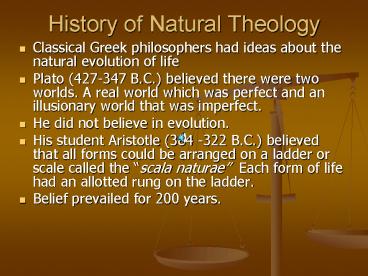History of Natural Theology - PowerPoint PPT Presentation
1 / 28
Title: History of Natural Theology
1
History of Natural Theology
- Classical Greek philosophers had ideas about the
natural evolution of life - Plato (427-347 B.C.) believed there were two
worlds. A real world which was perfect and an
illusionary world that was imperfect. - He did not believe in evolution.
- His student Aristotle (384 -322 B.C.) believed
that all forms could be arranged on a ladder or
scale called the scala naturae Each form of
life had an allotted rung on the ladder. - Belief prevailed for 200 years.
2
Carolus Linnaeus(1707- 1778)
- Father of taxonomy.
- Taxonomy is the branch of biology concerned with
naming and classifying organisms. - Came up with Kingdom, Phylum, Class, Order,
Genus, Species. - However he believed there was no evolutionary
kinship between them.
3
Georges Cuvier(1769-1832)
- Paleontologist.
- Documented and recorded the succession of fossils
in sedimentary strata in the Paris Basin. - Found deeper and older fossils to be dissimilar.
New species appear and older species disappear. - Advocated catastrophism. Species killed off by
catastrophes and recreated.
4
James Hutton(1726-1797)
- Scottish geologist.
- Proposed gradualism .
- Profound changes are due to gradual changes over
a long period of time due to natural processes
occurring within the Earths crust.
5
Charles Lyell (1997-1875)
- Proposed uniformitarianism. The idea that
geological processes have not changed over time
and are at work. - Suggested the earth was a lot older than the
previously thought 6000 years. - Processes persisting over long periods of time
can accumulate to substantial change.
6
Charles Lyell
7
Jean Baptist Lamark
- Was in charge of an invertebrate collection at
the Natural History Museum in Paris. - Noticed that species changed over time.
- Proposed that phenotype can change in response to
environment changes and those new characteristics
were passed on to the offspring. - First idea that adaptations occur in response to
the environment.
8
Jean Batist Lamark
9
The Darwinian Revolution
- Charles Darwin(1809 -1882) was born in Shrewsbury
England. - Wanted to be naturalist but was sent to medical
school in Edinborough at 16. - He dropped out and went to Christ College at
Cambridge University and became a clergyman.
Back then most naturalist were clergyman. - Viewed the world as natural theologists.
- The view that each species was newly designed
and non-evolving.
10
Darwin 1875
11
Reverend Robert Henslow
- Botany professor at Cambridge.
- Darwin was his protégé
- At age 22 he was recommended to join Captain
Robert Fitzroy on the H.M.S. Beagle to sail
around the world. - The primary mission was to chart the South
American coastline. - Darwin collected and observed the flora and
fauna.
12
H.M.S. Beagle Voyage
13
Descent With Modification
- A Darwinian View of Life
14
The Galapagos
- Species unique although they most closely
resembled South American species. - Darwins finches possessed different beaks to
accommodate different modes of eating. - Darwin read Principles of Geology by Lyell and
surmised that old Earth was inhabited by
evolving species.
15
Darwins Finches
16
The Origin of Species
- Lyell and a collegue presented Darwins work
Along with another Bristish scientist by the name
of Alfred Wallace. - The paper was on the theory of Natural
Selection which Wallace and Darwin came up with
simultaneously. - Darwin published The Origin of Species a year
later.
17
(No Transcript)
18
Alfred Wallace
19
Darwins Observations
- Species had distinct South American
characteristics. - South American species that lived in the
temperate regions more closely resembled the
tropical species on the same continent than
species that resided in the temperate regions on
a different continent. - South American fossils resembled south American
species.
20
Observations That Lead Darwin to the Theory of
Natural Selection
- OBSERVATIONS
- All species have the potential to reproduce the
maximum number of offspring. - Populations remain a stable (except for seasonal
fulgurations. - Resources are limited
- CONCLUSION
- Organisms compete for food.
21
Other Observations
- Organisms vary
- Organism with suitable traits survive to
reproduce. - Gradual changes in a population occur and the
population accumulates favorable characteristics.
22
Additional Evidence for Natural Selection
- Homology similarities in characteristics due to a
common ancestor. - Anatomical homologies
- similar structures, different function.
- Embryological homologies
- Similar structural development.
- Molecular homologies
- Basic machinery of RNA and DNA are similar.
- Biogiographic homologies
- Convergent evolution
23
Homologies
- Biogeographic homologies
- Endemic species.
- Convergent evolution - species that look similar
but have no common ancestry. - Divergent evolution species that have common
ancestry but evolve disparate characteristics. - Fossil Record the appearance of certain classes
of vertebrates in the fossil record. - Fish before amphibians
24
Homologous Structures
25
Convergent Evolution
26
Natural Selection
- Differential success in reproduction.
- Variation in populations and how they respond to
the environment. - The product of adaptation to their environment.
27
Descent With Modification
28
Cartoon of Darwin































